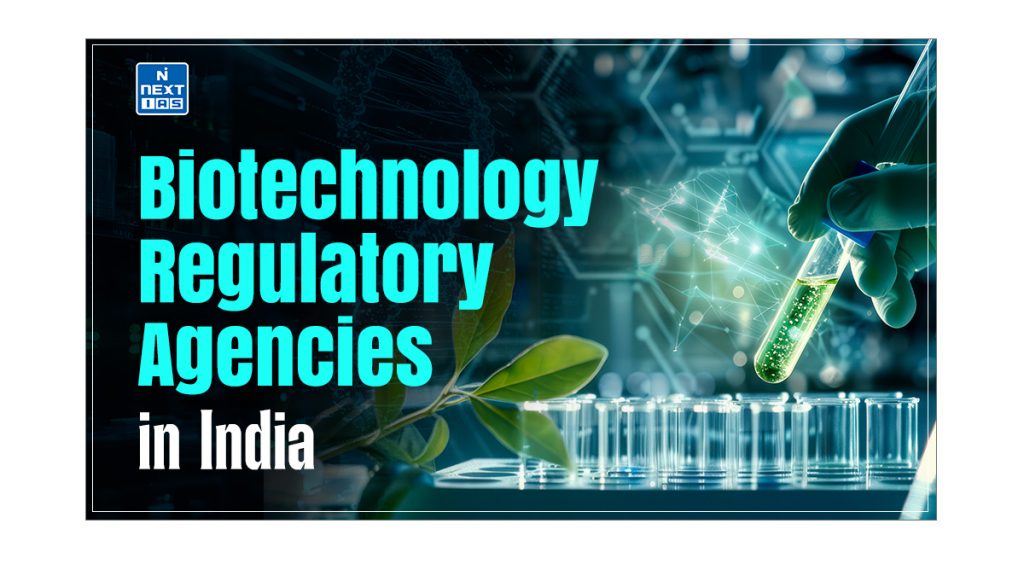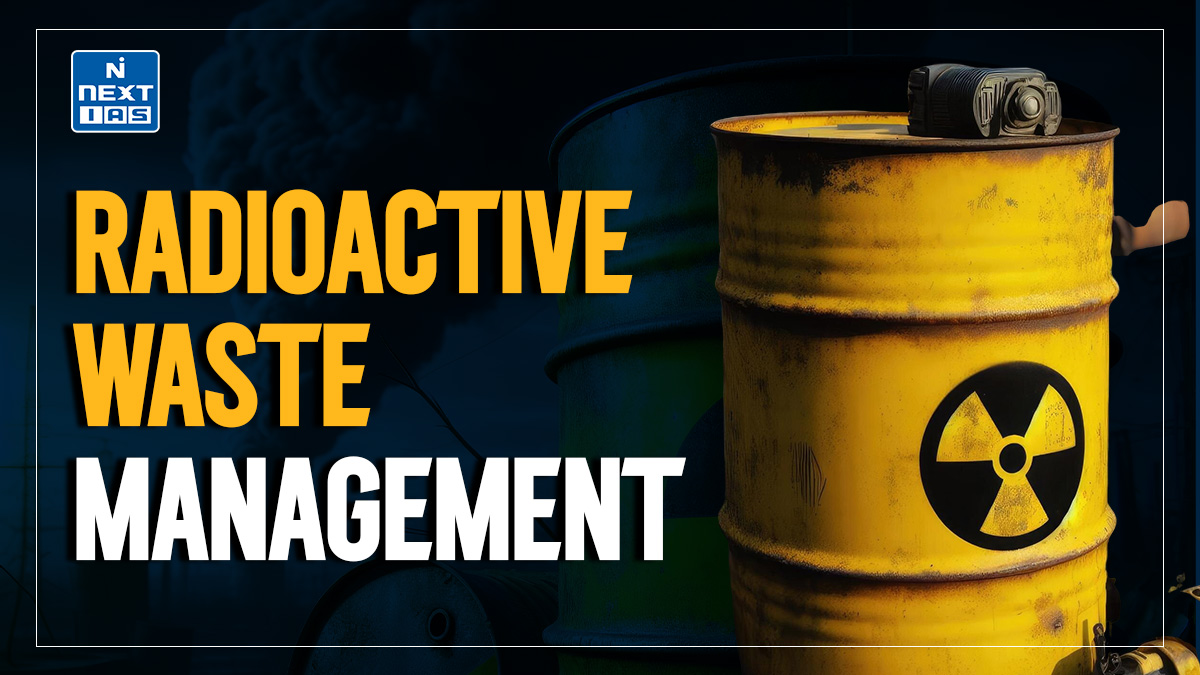
India’s biotechnology sector has experienced significant growth and innovation, driven by advancements in research and technology. To ensure the safety, efficacy, and ethical considerations of biotechnological applications, a robust regulatory framework is essential. Several key agencies oversee this sector, including the Department of Biotechnology (DBT), the Drugs Controller General of India (DCGI), and the Genetic Engineering Appraisal Committee (GEAC). This article aims to study Biotechnology and Regulatory Agencies in India.
Department of Biotechnology
- Realising the tremendous potential of biotechnology in improving human and animal health, enhancing agricultural activity, and providing a safe and clean environment, the government set up a multi-agency board, the National Biotechnology Board (NBTB), in 1982 with the participation of DST, UGC, ICMR, and CSIR to promote biotechnology activities.
- Subsequently, in 1986, the National Board was upgraded to a full-fledged Department of Biotechnology under the Ministry of Science and Technology, which provided the much-needed impetus to biotechnology.
- The Department of Biotechnology aims to achieve its vision by facilitating the emergence of a system that promotes excellence and sustains innovation through the implementation of novel schemes/programmes and institutional mechanisms to:
- Ensure availability of required numbers of world-class scientists and professionals relevant to R&D and technology development along with a well-trained and skilled technical workforce for industry;
- Establish adequate infrastructure, biotechnology incubators and clusters; engage public-private partnerships for development of products of social relevance for applications in agriculture, healthcare, environment and industry;
- Provide a fiscal, regulatory and legal framework that encourages risk taking by investors.
- From the setting up of a National Biotechnology Board in 1982, to a full-fledged Department in 1986, the DBT had attained several milestones in its 30-years journey.
Genetic Engineering Appraisal Committee (GEAC)
- The Ministry of Environment, Forest & Climate Change (MoEFCC) had notified the Rules for Manufacture, Use/Import/ Export & Storage of Hazardous Micro Organisms/ Genetically Engineered Organisms or Cells in 1989 with a view to protecting environment, nature and health in connection with application of gene technology and micro-organisms. These rules commonly referred as ‘Rules 1989’ cover areas of research as well as large scale applications of GMOs and their products including experimental field trials and seed production.
- The Genetic Engineering Approval Committee (GEAC), established under MoEFCC, is the apex body to accord notified under Rules 1989.
The functions of GEAC as prescribed in the Rules 1989 are as follows:
- To appraise activities involving large scale use of hazardous microorganisms and recombinants in research and industrial production from the environment angle.
- To appraise proposals relating to release of genetically engineered organisms and products into the environment including field trials.
- The committee or any persons authorized by it has powers to take punitive action under the Environment Protection Act.
Biotechnology Regulatory Authority Bill, 2013
The salient features of the Bill are:
- It sets up an independent authority, the Biotechnology Regulatory Authority of India, which will consist of a chairperson, two full time members, and two part-time members.
- The Functions of the Biotechnology Regulatory Authority of India shall include regulating the research, transport, import, containment, environmental release, manufacture and use of organisms and products of modern biotechnology. For this BRAI will comprise of three units – Risk Assessment Unit (RAU), Product Rulings Committee (PRC) and Environmental Appraisal Panel (EAP).
- The Authority also has the power to call for information, conduct an inquiry and issue directions for the safety of products or processes of modern biotechnology.
- Authority permits field trials for certain organisms or products if it feels it will be aiding the development of modern biotechnology such as genetically engineered plants, animals used in food or any animal clones that can be applied in agriculture, fisheries or food products.
- For the implementation of safety assessment procedures and processes, Regulatory divisions of the Authority have been created. The divisions are (i) Agriculture, Forests and Fisheries, (ii) Human health and veterinary products, and (iii) industrial and environmental applications.
- A State Biotechnology Regulatory Advisory Committee will act as a nodal agency between the state government and the Authority with regard to the regulation of modern biotechnology.
- A Biotechnology Regulatory Appellate Tribunal will hear appeals against the decisions, orders or directions of the Authority.
Appellate Tribunals are the part of the judicial system that is responsible for hearing and reviewing appeals from legal cases that have already been heard in a trial-level or other lower court.
- The welfare and progress of humanity through Biotechnology should be the main concern of the Government, all decisions and regulations should be on these lines only. Oversight of the research process for safety is a crucial aspect and would be instrumental in handling any fall out due to any research work which could be detrimental for the whole humanity, so some sort of oversight should be present.
- District level bodies could better analyse the effect and impacts on the local population, so the proposition for their setup should be put forward.
- Clarity on substantial questions relating to modern biotechnology should be clearly defined. The liability for any damage due to misuse or mishandling of the product of biotechnology must be fixed clearly.
- The Bill can help India harness huge potential from Biotechnology. Public objections/suggestions will be listened to is a positive step as Public welfare is the prime concern of the Government. However, issues like clarity of wordings of the bill, oversight of research must be tackled for achieving holistic and sustainable development through the use of Biotechnology.
National Guidelines for Stem Cell Research
These guidelines has been issued by ICMR in association with Department of Biotechnology. The guidelines seek to ensure standards on various processes related to stem cell treatment.
- It stated that commercial banking of all biological materials, other than Umbilical Cord Blood (UCB), is prohibited until further notification.
- ICMR quoted that at present there is no scientific evidence to substantiate clinical benefits with the use of stem cells other than UCB. Yet its procurement and banking has become a commercial activity.
- Thus the banking of stem cells derived from cord tissue, placenta, tooth extract, adipose tissue, dental pulp, menstrual blood and olfactory ensheathing cells is not permitted.
- ICMR has approved the stem-cell treatment for 30 odd categories of diseases mostly cancer.
- It listed 20 types of indications (diseases) for adults and another 13 categories of indications for children below 18 years, where stem cell treatments are permitted.
- The guidelines also mention that every other therapeutic use of stem cells shall be treated as investigational and conducted only in the form of a clinical trial after obtaining necessary regulatory approvals.
- These guidelines are applicable to all stakeholders including individual researchers, organizations, sponsors, oversight/regulatory committees and all others associated with both basic and clinical research involving any kind of human stem cells and their derivatives.
- It does not apply to research using non-human stem cells or tissues.
- Intellectual Property Rights (IPRs) associated with the outcome of research on stem cells may have commercial value.
- The option of sharing such IPRs should be indicated in the informed consent form which must be procured before the commencement of the research.
Conclusion
Regulating biotechnology in India ensures safety, ethics, and sustainable development. Agencies like the DBT and GEAC oversee research, product development, and environmental release. The Biotechnology Regulatory Authority Bill, 2013, aims to enhance oversight and foster responsible innovation, while the National Guidelines for Stem Cell Research ensure transparency and safety.
These frameworks build public trust, mitigate risks, and balance innovation with safety, empowering India to leverage biotechnology for health, agriculture, industry, and environmental protection. Improving clarity, oversight, and public involvement will further strengthen this regulatory landscape.





